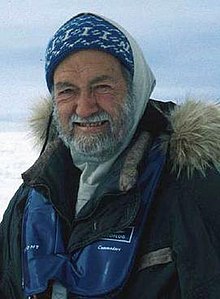Wally Herbert
Sir Wally Herbert | |
|---|---|
 | |
| Born | 24 October 1934 |
| Died | 12 June 2007 (aged 72) |
| Nationality | British |
| Occupation(s) | Explorer, writer, artist |
| Known for | Polar exploration |
| Notable work | The Noose of Laurels |
Sir Walter William Herbert (24 October 1934 – 12 June 2007) was a British polar explorer, writer and artist. In 1969 he became the first man fully recognized for walking to the North Pole, on the 60th anniversary of Robert Peary's disputed expedition.[1] He was described by Sir Ranulph Fiennes as "the greatest polar explorer of our time".
During the course of his polar career, which spanned more than 50 years, he spent 15 years in the wilderness regions of the polar world. He travelled with dog teams and open boats well over 23,000 miles; more than half of that distance through unexplored areas.[2]
Among his several books, which he illustrated, were works dealing with polar exploration. He also had solo exhibitions of his drawings and paintings. In 2000 he was knighted for his polar achievements.
Early life and career
Walter Herbert was born into an army family in England who emigrated to Egypt on assignment when he was three. They moved on to South Africa for nine years. He studied at the Royal School of Military Survey, then spent 18 months surveying in Egypt and Cyprus. He travelled back to England through Turkey and Greece, drawing portraits for his board and lodging.
In 1955, when Herbert was 21, he carried out surveying in the
As leader of an exploration party in the early 1960s, Herbert surveyed a large area of the
.British Trans-Arctic Expedition
From 1968 to 1969, Herbert led the British Trans-Arctic Expedition, a 3,800-mile overland crossing of the Arctic Ocean, from
In recognition of his polar achievements, Herbert received several honours and awards: among them the
Later life
When he returned to London in 1969 he married Marie Herbert. Together they lived with the Inuit and Saami in Greenland, Norway and Sweden. They had two daughters who travelled with them; their elder daughter is Kari Herbert.
Between 1979 and 1981 Herbert and Allan Gill attempted to circumnavigate Greenland by dog sled and umiak, a traditional boat. It was planned to take 16 months to cover the 13,000 km (8000 miles) but poor weather made it impossible. Near Loch Fyne, Herbert wrote:
We were forced to take to the land and haul the sledges across steaming tundra and rock bare of snow, swollen rivers, baked mud flats, sand-dunes, swamps and stagnant pools. We were blasted by duststorms and eaten alive by mosquitoes
Wally Herbert died in Inverness on 12 June 2007.
Author and artist
Herbert was a prize-winning author and an artist and had one-man shows in London, New York and Sydney.[2] He wrote a number of books and drew some of the first landscapes of the North Pole, in his early exploration days. He illustrated all of his books, and his paintings and drawings received critical acclaim. Some of Herbert's own famous pieces can be found on his website.[5]
Herbert was drawn by Andrew James.[6] One of the only known portraits of Herbert, the work was given by him as a gift to fellow explorer Andrew Regan.
Peary controversy
Herbert's research challenged Robert Peary's claim to have reached the North Pole in 1909. The National Geographic Society, which had supported Peary's original expedition, hired Herbert to assess a 1909 diary and astronomical observations, which had not been accessible to researchers for decades. Herbert concluded that the explorer had not reached the Pole and must have falsified the records.[4] His book, The Noose of Laurels: The Race to the North Pole (1989), caused a furore when it was published, and its conclusion is widely debated.[7] The Foundation for the Promotion of the Art of Navigation, commissioned by the National Geographic Society to resolve the issue, disagreed, and concluded that Peary had indeed reached the Pole.[8] Since then the National Geographic Society has come to accept Herbert's version of events.[9]
Legacy and honours
- Herbert was knighted in 2000.[2]
- After his 1969 achievement in reaching the pole, he was awarded the Explorers Club.
- A mountain range and a plateau were named after him in the Antarctic.
- The most northerly mountain in Svalbard, an Arctic archipelago, was named after him.
Bibliography of his works
- The Polar World: The Unique Vision of Sir Wally Herbert, 2007 (collection of his artwork)
- The Noose of Laurels: The Race to the North Pole, 1989 (published as The Noose of Laurels: Robert E. Peary and the Race to the North Pole by Atheneum Books in the US)
- Hunters of the Polar North: Eskimos, 1981
- Eskimos, 1976 (won the 1977 Deutscher Jugendliteraturpreis)
- North Pole, 1978
- Polar Deserts, 1971
- Across the Top of the World, 1969
- A World of Men: Exploration in Antarctica, 1963/reprint 1969
References
- ^ "Channel 4 News". Retrieved 30 December 2016.
- ^ a b c d "Greatest polar explorer' Sir Wally Herbert dies". The Times Online. 13 June 2007.
- ISBN 978-0500252147.
- ^ a b "Sir Wally Herbert". The American Polar Society. Retrieved 11 September 2019.. Dead link, the archived version here: http://www.americanpolar.org/sir-wally-herbert/
- ^ "Sir Wally Herbert - A Bio page about Sir Wally Herbert". Retrieved 30 December 2016.
- ^ "Andrew James", Royal Society of Portrait Artists
- ^ Obituary: Sir Wally Herbert, The Independent, 16 June 2007 [dead link]
- ISBN 9780914025207
- ^ "The History of the North Pole expeditions". The National Geographic Society. 24 January 2020. Archived from the original on 24 January 2020. Retrieved 28 December 2020.
Further reading
- Richard Sale, Polar Reaches: The History of Arctic and Antarctic Exploration, Mountaineer Books, 2002
External links
- Sir Wally Herbert's homepage
- Sir Wally Herbert, Obituaries, The Guardian, 15 June 2007
